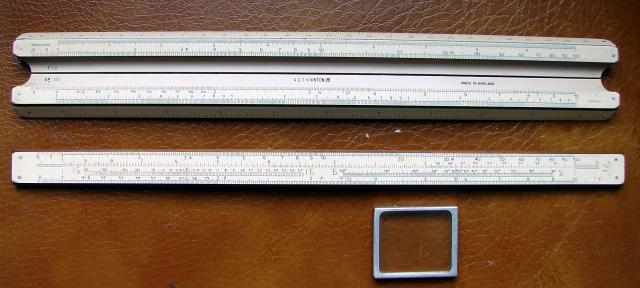My Grandfather's Slide Rule
My grandfather, Len Dawson, was born in England in 1919. Professionally he started out as a draftsman, he was a civil engineer by trade, doing a variety of related jobs over the course of his career, most of them relating to nuclear power plant design. He had a slide rule, an A.G. Thornton P.I.C. 111. It is carved on the back with his initials LD, and has passed on to me.The Slide Rule Museum has a photo in their British Slide Rules section of a Thornton PIC 101, very similar except not having some of the scales on my grandfather's PIC 111. This 111 is not labeled ENGINE DIVIDED, and does not seem to be engraved in that way. They call this a "British Thornton", although the company was only so named from 1960 onward.
The Math Instruments site lists this slide rule and has a low resolution photo: "Thornton PIC No 111 closed frame slide rule made of plastic faced mahogany with a metal and glass cursor. The scales are: L,A{B,C1,Sd,Td,C}D,K. There are inch and centimetre rules on the top and bottom edges. It has a green cloth covered card case. There are tables on the back. Date code C46."
Here are some photos. They were taken quickly and from very close range,
the apparent curve, and the blurriness at the ends, is from the camera
being too close. There is wear on the slide, at the right end, where
my grandfather would have held it most often during use.



The ISd, ITd, Td and Sd scales were quite confusing to me when I started trying to use the rule. I found this on John Savard's Home Page, and it explains the reasoning behind having these on a slide rule: "Sd, Td, ISd, ITd: These scales show the ratio of the sine, tangent, inverse sine, and inverse tangent to their arguments (in degrees). These four scales have ranges that do not overlap, and thus they only occupy the same space as a single normal full-length scale. While these ratios are not often used directly in calculations, these scales can be used to provide sines and tangents with the same accuracy, and over the same range, as the complete set of four full-length scales S1, S2, T, and ST, and thus one maker of slide rules (P.I.C.) used these scales as a replacement for conventional trigonometric scales on some models of slide rule, despite the fact that this means that multiplying a quantity by the sine of an angle would take two steps instead of one.".
From a 1962 A.G. Thornton slide rule instruction manual: "1933 - PIC Differential trigonometric and log log scales invented by Hubert Boardman, Radcliffe, Lancashire." Dating this rule to later than 1933, which is reasonable since my grandfather would have been 11 that year and not likely buying such an instrument!